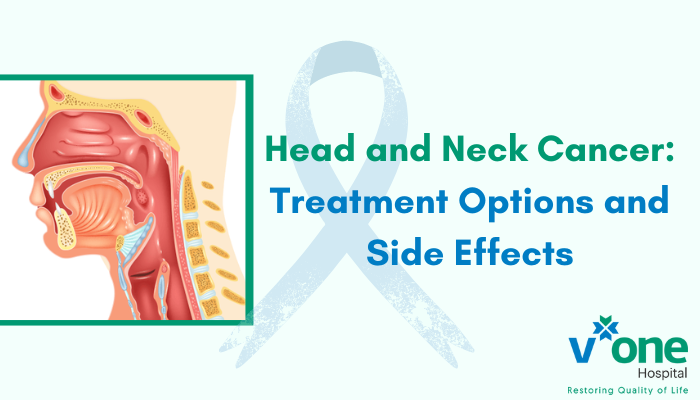Head and Neck Cancer – Main Treatment Options
Did you know that around 57.5% of head and neck cancers happen in Asia, especially in India? In fact, they form 30% of all our cancer cases, and 60 to 80% of our patients show advanced symptoms (this is only 40% in developed countries).
If you have just received your diagnosis and are wondering about your treatment options, you are not alone. In this blog, we have compiled a list of some of the most common and successful treatment options available for head and neck cancer (along with their side effects).
What is Head and Neck Cancer?
A cancer of the mouth, throat, sinus, or nose, that usually begins in the squamous cells lining the mucosal surfaces of the head and neck, is called a head and neck cancer, or a squamous cell carcinoma of the head and neck. While less common, such a cancer can also begin in the salivary glands, sinuses, or muscles or nerves in the head and neck. To elaborate, these cancers can form in the oral cavity, the pharynx, the larynx, paranasal sinuses and the nasal cavity, and salivary glands.
What Causes Head and Neck Cancer?
These cancers can be brought on by alcohol, tobacco, and paan use, occupational exposure and exposure to radiation, ancestry and genetic disorders, and exposure to HPV or the Epstein-Barr virus.
Head and Neck Cancer Treatment
Many head and neck cancers can be cured, and finding these early helps a lot with this. But while the goal is to get rid of the cancer, it’s also important to preserve the function of the nearby nerves, organs, and tissues.
Depending on a number of factors like location of tumor, type and stage of cancer, possible side effects, and the patient’s age and health status, available treatments for head and neck cancers are immunotherapy, chemotherapy, radiation therapy, targeted therapy, surgery, or a combination of treatments. Choosing a treatment should also involve discussing how it will affect the patient’s quality of life and how they will be able to look, talk, eat, or breathe after the treatment.
1. Immunotherapy
A.k.a Biologic therapy, immunotherapy uses body-materials or lab-made ones to boost the body’s natural defenses so it can fight the cancer with an improved immune system.
Possible Side Effects:
- Skin reactions
- Diarrhea
- Flu-like symptoms
- Weight changes
2. Chemotherapy
Certain drugs can prevent cancer cells from growing, dividing, and multiplying, effectively destroying them. In a number of cycles over a certain period of time, this can be done using one drug at a time or a combination at once.
Possible Side Effects:
- Fatigue
- Nausea/Vomiting
- Diarrhea
- Loss of hair or appetite
- Risk of infection
3. Radiation Therapy
Radiation therapy uses high-energy X-rays or other particles to destroy cancer cells. In a number of cycles over a certain period of time, it can cure the cancer and reduce symptoms. Types include external-beam radiation therapy, proton therapy, and internal radiation therapy.
Possible Side Effects:
- Tooth decay
- Difficulty swallowing
- Changes in voice
- Changed sense of taste, loss of appetite
- Damaged salivary glands, dry mouth
- Irritated skin, swelling, bone pain
- Nausea, fatigue
- Mouth sores, sore throat
4. Targeted Therapy
By targeting the cancer’s specific genes, proteins, or tissue environment, this treatment prevents cancer cells from growing and spreading, and reduces damage to healthy cells.
Possible Side Effects:
- Fatigue
- High BP
- Problems with blood clotting and wound healing
- Mouth sores
- Loss of hair color
- Nail changes
- Skin problems
5. Surgery
Surgery is always an option to remove the cancerous tumor and some surrounding healthy tissue. This can be through laser, excision, lymph node or neck dissection, and reconstructive plastic surgery.
Possible Side Effects:
- Loss of normal voice (temporary or permanent)
- Impaired speech
- Hearing loss
- Difficulty chewing/swallowing
- Stiff shoulders
- Swollen mouth and throat, difficulty breathing
According to the head and neck cancer treatment guidelines and depending on the type and stage of cancer, among other factors to consider, your doctor should sit you down and jointly reach a decision regarding the treatment plan and the way forward. This discussion should involve the possible side effects and what life will be like after the treatment.
When the cancer is no longer detected in your body, it is called remission – although this can be temporary or permanent. If it does return, such recurrent cancer will begin a new cycle of testing and treatment for you.

